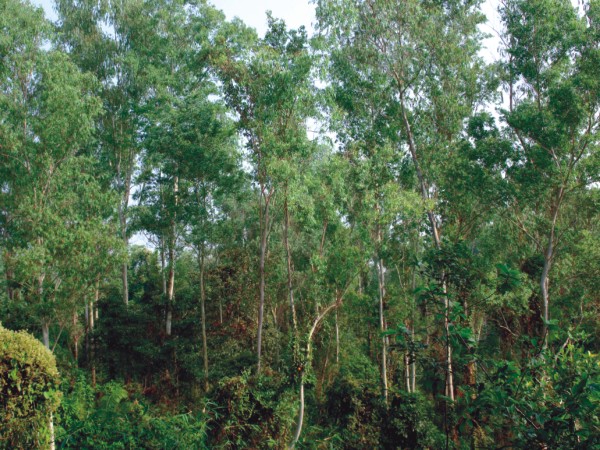|
Environment
Deadly Beauties
Destruction of the natural forest of southern Lowachara
Zannatul Ferdous
 |
An adivasi woman of Duluchara.
Photos: Zannatul Ferdous |
Southern Lowachara, near the Sreemongal town of Moulvibazar district has an area of 50 acres having natural forest. This natural forest has been totally destroyed by the Forest Department and instead, an artificial aforestation has been taking place by planting saplings of eucalyptus trees.
Lawachara is one of the major national parks in Bangladesh. In 1997 the Bangladesh government declared it a national park. This forest was built by the British during the time of their rule in the Indian Subcontinent. Eight kilometres east from Srimongal town under Kamalganj Upazila of Maulvibazar District, the 1,250 hectares national park in Lawachara is the most beautiful tropical forest. The park is named after a small narrow tributary, named 'Lawachara'. Its previous name was 'West Bhanugan'.
Biodiversity in the Lawachara National Park consists of 460 species, of which 167 species are plants, four amphibian species, six reptile species, 246 bird species and 20 mammal species.
“We grow fruits, such as lemon, jackfruit, pineapple, guava and our main source of water has, hitherto been the Duluchhara hilly river. But now we are facing acute scarcity of water, even in the rainy season”, says Janak Dev Barman, General Secretary of Tripura Kalyan Sangsad, Sylhet, of the Duluchhara adivasi village. Maya Dev Barman, another adivasi of that village and a second year student of Honours in political science adds that when she was a child the Duluchhara used to be full of fish; now there are none as it has almost dried up.
Shyamal Dev Barman, an environmental worker says that the Lawachhara forest was declared a protected forest in the year 1922-23, but, strangely enough, around the year 1986-87, the all trees of the forest were felled, and eucalyptus trees planted in their place.
He adds, “eucalyptus trees have totally destroyed the ecological balance, for the last ten years, as it sucks the water from land, and grows fast, creating a dry atmosphere there. There are no insects in eucalyptus trees and hence animals such as monkeys, squirrels, birds, snakes etc. that feed on them, are totally absent."
 |
Pretty but deadly for the forest. Eucalyptus at Duluchara, Lowachara.
Photos: Zannatul Ferdous |
Shyamal explains further that even in terms of the quality of timber, eucalyptus trees are not that great and can only be used as fuel in the form of bundles of twigs. In his opinion the artificial aforestation of eucalyptus trees, has also adversely affected the livelihoods of the indigenous people. “Now we are facing great difficulties in earning their daily bread” he says.
Mohammad Abul Hossan, Range Officer, Moulvibazar Forest Division, says, “since my appointment in 1976, I witnessed many forests being destroyed in this way, by planting eucalyptus trees, and the southern Lowachhara forest was destroyed long before my posting here, as I found big eucalyptus trees here.”
He adds, "I can't say whether the Duluchhara rivulet has dried up due to aforestation by eucalyptus.” He further says that, a controversy is going on, on the point whether eucalyptus trees affect the environment adversely, and no conclusive scientific evidence is available up till now.
The senior official, however, informs that, whatever may be the effect, the planting of eucalyptus have totally been stopped for the last five years by the Forest Department. He refutes that eucalyptus has only use as fuel by burning twigs, but furniture can also be made from it he says, but admits that the finishing is not as good as other varieties of wood.
Copyright
(R) thedailystar.net 2010 |
| |
